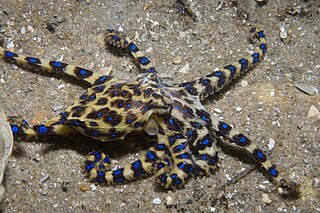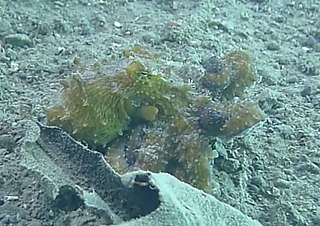
An octopus is a soft-bodied, eight-limbed mollusc of the order Octopoda. The order consists of some 300 species and is grouped within the class Cephalopoda with squids, cuttlefish, and nautiloids. Like other cephalopods, an octopus is bilaterally symmetric with two eyes and a beaked mouth at the center point of the eight limbs. The soft body can radically alter its shape, enabling octopuses to squeeze through small gaps. They trail their eight appendages behind them as they swim. The siphon is used both for respiration and for locomotion, by expelling a jet of water. Octopuses have a complex nervous system and excellent sight, and are among the most intelligent and behaviourally diverse of all invertebrates.

A cephalopod is any member of the molluscan class Cephalopoda such as a squid, octopus, cuttlefish, or nautilus. These exclusively marine animals are characterized by bilateral body symmetry, a prominent head, and a set of arms or tentacles modified from the primitive molluscan foot. Fishers sometimes call cephalopods "inkfish", referring to their common ability to squirt ink. The study of cephalopods is a branch of malacology known as teuthology.

Blue-ringed octopuses, comprising the genus Hapalochlaena, are four extremely venomous species of octopus that are found in tide pools and coral reefs in the Pacific and Indian oceans, from Japan to Australia. They can be identified by their yellowish skin and characteristic blue and black rings that can change color dramatically when the animal is threatened. They eat small crustaceans, including crabs, hermit crabs, shrimp, and other small sea animals.

The mimic octopus is a species of octopus from the Indo-Pacific region. Like other octopuses, it uses its chromatophores to disguise itself. It is noteworthy for being able to impersonate a wide variety of other marine animals. While many animals mimic either their environment or other animals to avoid predation, the mimic octopus and its close relative the wunderpus are the only ones known to actively imitate several animals in order to elude predators.

The southern blue-ringed octopus is one of three highly venomous species of blue-ringed octopuses. It is most commonly found in tidal rock pools along the south coast of Australia. As an adult, it can grow up to 20 centimetres (8 in) long and on average weighs 26 grams (0.9 oz). They are normally a docile species, but they are highly venomous, possessing venom capable of killing humans. Their blue rings appear with greater intensity when they become aggravated or threatened.

The greater blue-ringed octopus is one of four species of extremely venomous blue-ringed octopuses belonging to the family Octopodidae. This particular species of blue-ringed octopus is known as one of the most toxic marine animals in the world.

Octopus is the largest genus of octopuses, comprising more than 100 species. These species are widespread throughout the world's oceans. Many species formerly placed in the genus Octopus are now assigned to other genera within the family. The octopus has 8 arms, averaging 20 cm (8 in) long for an adult.

Sepia mestus, also known as the reaper cuttlefish or red cuttlefish, is a species of cuttlefish native to the southwestern Pacific Ocean, specifically Escape Reef off Queensland to Murrays Beach off Jervis Bay. Reports of this species from China and Vietnam are now known to be misidentifications. S. mestus lives at a depth of between 0 and 22 m.
Abdopus is a genus of octopuses in the family Octopodidae.

Abdopus aculeatus is a small octopus species in the order Octopoda. A. aculeatus has the common name of algae octopus due to its typical resting camouflage, which resembles a gastropod shell overgrown with algae. It is small in size with a mantle around the size of a small orange and arms 25 cm in length, and is adept at mimicking its surroundings.

Macrotritopus defilippi, commonly known as the Lilliput longarm octopus or the Atlantic longarm octopus, is a small species of octopus, a marine cephalopod mollusc of the order Octopoda.

Octopus tetricus, the gloomy octopus or the common Sydney octopus, is a species of octopus from the subtropical waters of eastern Australia and New Zealand. O.tetricus belongs to the Octopus vulgaris species group and is a commercially prized species. All species within the O. vulgaris group are similar in morphology. The English translation of O. tetricus (Latin) is 'the gloomy octopus'.

Abdopus horridus, the Red Sea octopus or common reef octopus, is a species of octopus in the genus Abdopus from the western Indian Ocean. It occurs in the western Indian Ocean and the Red Sea. It has a small body and long arms with a complex skin sculpture and pigmentation pattern on the body which it uses to camouflage itself. If a predator attacks this species it is capable of autotomising its arms, once autotomisised the arm can grow back in 2–3 months. Abdopus horridus is the type species of its genus but within that genus it is rather distinct and lays larger eggs than its congeners, many of which were previously thought to be populations of this species under its synonym Octopus horridus.

The larger Pacific striped octopus (LPSO), or Harlequin octopus, is a species of octopus known for its intelligence and gregarious nature. The species was first documented in the 1970s and, being fairly new to scientific observation, has yet to be scientifically described. Because of this, LPSO has no official scientific name. Unlike other octopus species which are normally solitary, the LPSO has been reported as forming groups of up to 40 individuals. While most octopuses are cannibalistic and have to exercise extreme caution while mating, these octopuses mate with their ventral sides touching, pressing their beaks and suckers together in an intimate embrace. The LPSO has presented many behaviors that differ from most species of octopus, including intimate mating behaviors, formation of social communities, unusual hunting behavior, and the ability to reproduce multiple times throughout their life. The LPSO has been found to favor the tropical waters of the Eastern Pacific.

Wunderpus photogenicus, the wunderpus octopus, is a small-bodied species of octopus with distinct white and rusty brown coloration. 'Wunderpus' from German “wunder” meaning ‘marvel or wonder’.
Octopus oliveri, is a species of octopus found in the western Pacific Ocean off the coast of Japan, Hawaii, and Kermadec Island, in reefs and boulder coasts.

Octopus insularis is a species of octopus described in 2008 from individuals found off the coast of Brazil, with a potentially much larger range.

Abdopus abaculus, or the mosaic octopus, is a species of pygmy octopus. It was first described as Octopus abaculus by M. D. Norman and M. J. Sweeney in 1997 based on specimens caught in Zamboanga del Norte, Philippines.
Octopus bocki is a species of octopus, which has been located near south Pacific islands such as Fiji, the Philippines, and Moorea and can be found hiding in coral rubble. They can also be referred to as the Bock's pygmy octopus. They are nocturnal and use camouflage as their primary defense against predators as well as to ambush their prey. Their typical prey are crustaceans, crabs, shrimp, and small fish and they can grow to be up to 10cm in size.

Octopus hubbsorum, is an octopus in the family Octopodidae. It is commonly found along tropical waters along the central Pacific Coast of Mexico. Here, they are one of the most commonly caught cephalopods and are commercially extremely important for the economy.















